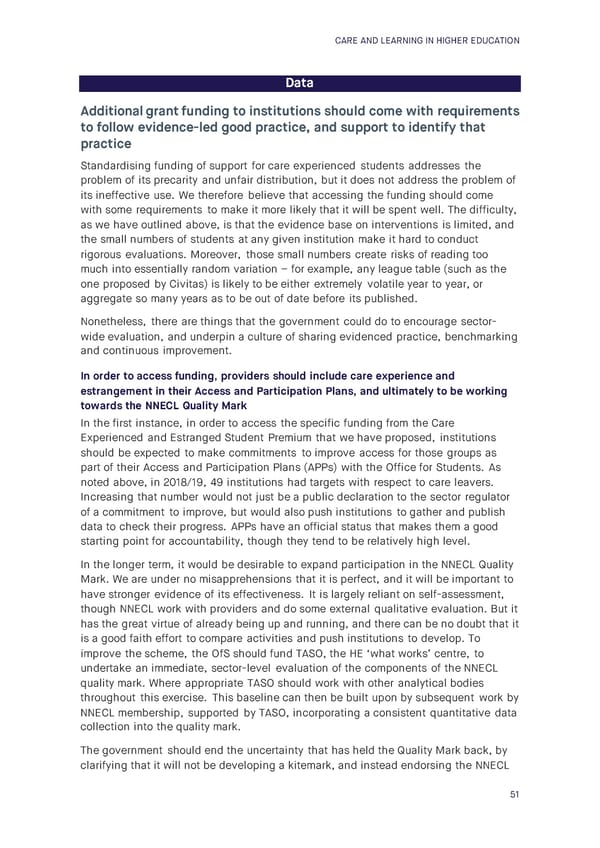CARE AND LEARNING IN HIGHER EDUCATION Data Additional grant funding to institutions should come with requirements to follow evidence-led good practice, and support to identify that practice Standardising funding of support for care experienced students addresses the problem of its precarity and unfair distribution, but it does not address the problem of its ineffective use. We therefore believe that accessing the funding should come with some requirements to make it more likely that it will be spent well. The difficulty, as we have outlined above, is that the evidence base on interventions is limited, and the small numbers of students at any given institution make it hard to conduct rigorous evaluations. Moreover, those small numbers create risks of reading too much into essentially random variation – for example, any league table (such as the one proposed by Civitas) is likely to be either extremely volatile year to year, or aggregate so many years as to be out of date before its published. Nonetheless, there are things that the government could do to encourage sector- wide evaluation, and underpin a culture of sharing evidenced practice, benchmarking and continuous improvement. In order to access funding, providers should include care experience and estrangement in their Access and Participation Plans, and ultimately to be working towards the NNECL Quality Mark In the first instance, in order to access the specific funding from the Care Experienced and Estranged Student Premium that we have proposed, institutions should be expected to make commitments to improve access for those groups as part of their Access and Participation Plans (APPs) with the Office for Students. As noted above, in 2018/19, 49 institutions had targets with respect to care leavers. Increasing that number would not just be a public declaration to the sector regulator of a commitment to improve, but would also push institutions to gather and publish data to check their progress. APPs have an official status that makes them a good starting point for accountability, though they tend to be relatively high level. In the longer term, it would be desirable to expand participation in the NNECL Quality Mark. We are under no misapprehensions that it is perfect, and it will be important to have stronger evidence of its effectiveness. It is largely reliant on self-assessment, though NNECL work with providers and do some external qualitative evaluation. But it has the great virtue of already being up and running, and there can be no doubt that it is a good faith effort to compare activities and push institutions to develop. To improve the scheme, the OfS should fund TASO, the HE ‘what works’ centre, to undertake an immediate, sector-level evaluation of the components of the NNECL quality mark. Where appropriate TASO should work with other analytical bodies throughout this exercise. This baseline can then be built upon by subsequent work by NNECL membership, supported by TASO, incorporating a consistent quantitative data collection into the quality mark. The government should end the uncertainty that has held the Quality Mark back, by clarifying that it will not be developing a kitemark, and instead endorsing the NNECL 51
 Care and Learning in Higher Education Page 51 Page 53
Care and Learning in Higher Education Page 51 Page 53